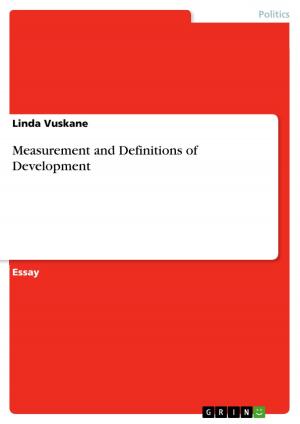The Legislatures of the United States And Germany. A Comparison
Nonfiction, Social & Cultural Studies, Political Science| Author: | Maren Reyelt | ISBN: | 9783638126762 |
| Publisher: | GRIN Publishing | Publication: | May 17, 2002 |
| Imprint: | GRIN Publishing | Language: | English |
| Author: | Maren Reyelt |
| ISBN: | 9783638126762 |
| Publisher: | GRIN Publishing |
| Publication: | May 17, 2002 |
| Imprint: | GRIN Publishing |
| Language: | English |
Seminar paper from the year 2001 in the subject Politics - International Politics - Region: USA, grade: very good, University of Wyoming (Department of Political Science), course: U.S. Presidency And Congress, 22 entries in the bibliography, language: English, abstract: 'Legislatures have one core defining function: that of giving assent to measures that, by virtue of that as-sent, are to be binding on society. In practice, they have usually other roles as well, such as debating meas-ures or the conduct of public affairs. They have existed for centuries. They span the globe. Most countries have one; federal states have several.' This statement applies to both institutions my paper deals with: to the United States Congress as well as to Germany's parliament. The constitutional core of both political systems is actually a powerful bicameral parliament vested with the power to enact legislation. However, the structure of power of the American Congress in comparison to the German system is different in regard to the relationship of both chambers to each other on the one hand and to the executive on the other hand. But both institutions share the same essential functions of representing the people of their country, of counterbalancing the executive power and of developing legislation. Germany's political system is build upon a parliamentary structure, where the power of the executive depends on a prime minister or chancellor and his cabinet getting their mandate from the legislature and thus being responsible to and depending on the support of it. On the contrary, the United States features a presidential system, where the president is both head of the state and head of the government, independent from the legislature, which can be dominated by the oppos-ing party (divided government). But this does not mean that the two branches cannot be com-pared. Because of their position within the federal system (as described above) and the similar composition of the branches, a comparison is more than just possible. It was the high influence of the allied powers and in particular of the United States occupation policy after World War II that made the German parliament bicameral. Its first chamber, the Bundestag (Federal Diet) corresponds to the United States House of Representa-tives, the Bundesrat (Federal Council) is comparable to the United States Senate - although I have to admit, that Germany's chambers are created unequal.
Seminar paper from the year 2001 in the subject Politics - International Politics - Region: USA, grade: very good, University of Wyoming (Department of Political Science), course: U.S. Presidency And Congress, 22 entries in the bibliography, language: English, abstract: 'Legislatures have one core defining function: that of giving assent to measures that, by virtue of that as-sent, are to be binding on society. In practice, they have usually other roles as well, such as debating meas-ures or the conduct of public affairs. They have existed for centuries. They span the globe. Most countries have one; federal states have several.' This statement applies to both institutions my paper deals with: to the United States Congress as well as to Germany's parliament. The constitutional core of both political systems is actually a powerful bicameral parliament vested with the power to enact legislation. However, the structure of power of the American Congress in comparison to the German system is different in regard to the relationship of both chambers to each other on the one hand and to the executive on the other hand. But both institutions share the same essential functions of representing the people of their country, of counterbalancing the executive power and of developing legislation. Germany's political system is build upon a parliamentary structure, where the power of the executive depends on a prime minister or chancellor and his cabinet getting their mandate from the legislature and thus being responsible to and depending on the support of it. On the contrary, the United States features a presidential system, where the president is both head of the state and head of the government, independent from the legislature, which can be dominated by the oppos-ing party (divided government). But this does not mean that the two branches cannot be com-pared. Because of their position within the federal system (as described above) and the similar composition of the branches, a comparison is more than just possible. It was the high influence of the allied powers and in particular of the United States occupation policy after World War II that made the German parliament bicameral. Its first chamber, the Bundestag (Federal Diet) corresponds to the United States House of Representa-tives, the Bundesrat (Federal Council) is comparable to the United States Senate - although I have to admit, that Germany's chambers are created unequal.















